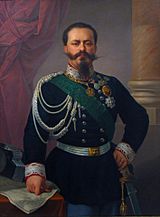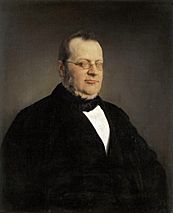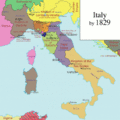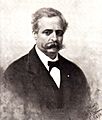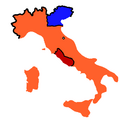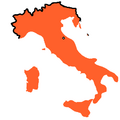Italian unification facts for kids
Quick facts for kids 
Map showing the unification of Italy, 1829–1871
|
|
| Native name | Unità d'Italia |
|---|---|
| Date | 1815–1871 |
| Location | Italy |
| Also known as | Risorgimento |
The Italian unification (also called the Risorgimento, meaning "the Resurgence") was a big movement in the 1800s. It brought together many small Italian states into one country. This journey started in 1815 after a big meeting called the Congress of Vienna.
It finished in 1871 when Rome became the capital of the new Kingdom of Italy. Key leaders like Count Cavour and the national hero Giuseppe Garibaldi helped make this happen. Thanks to them, King Victor Emmanuel II became the first king of Italy.
Contents
How Italy Became One Country
Napoleon's Big Defeat
Napoléon Bonaparte invaded Italy in 1796 and took control of it. When he was defeated in 1815 at the Battle of Waterloo, the Italian states became free again. This made it possible for them to think about joining together.
After Napoleon's fall, a meeting called the Congress of Vienna (1814–1815) brought back the old rulers. The Austrian Empire and the Habsburg family ended up controlling most of Italy.
Sardinia's Plan for Unity
Victor Emmanuel II was the king of Piedmont-Sardinia. He had a big dream of a united Italy. He wanted his kingdom to be a great example for the rest of Italy.
To achieve this, he started many public projects and made important political changes. Soon, Piedmont-Sardinia was seen as a rising power. The next step was to get Austria out of the Italian Peninsula.
When the Crimean War started, Piedmont-Sardinia joined France and Britain against Russia. This gave them a chance to gain respect. France and Britain won, and Sardinia got to attend the peace conference. This helped Piedmont-Sardinia get the support of Napoléon III, the leader of France.
War Against Austria
In 1858, Sardinia and France secretly planned to attack Austria. The next year, Sardinia put their plan into action. Instead of attacking directly, Sardinia encouraged people in Austrian-held parts of Italy to revolt. This made Austria angry enough to start the war.
After battles like Magenta and Solferino, France helped push Austria out of Lombardy. However, Austria still held onto Venetia. At this point, France stopped fighting. They worried that a fully united Italy might become too powerful. They also realized Austria was very strong. So, the war ended, and Austria kept Venetia.
Italy Becomes One Nation
While the war was happening, an Italian nationalist hero named Giuseppe Garibaldi led his own uprising. He combined several states and territories into a republic. When Sardinia finished its war, Garibaldi gave most of these areas to Sardinia.
In March 1861, a parliament with representatives from all of Italy (except Rome and Venetia) agreed to unite Italy. Victor Emmanuel became its first king. Later, when Prussia defeated Austria in a war in 1866, Italy made a deal. This forced Austria to give Venetia to Italy. This left Rome as the last Italian city not yet part of the new country.
Rome Becomes the Capital
The Franco-Prussian War started in 1870. Because of this war, France had to pull its army away from Rome. Without French protection, the Pope could not stop the Italian forces. So, Rome finally became the capital of Italy. This completed the long journey of Italian unification.
Related pages
Images for kids
-
Flag of the Cispadane Republic, which was the first Italian tricolour adopted by a sovereign Italian state (1797)
-
Giuseppe Mazzini, highly influential leader of the Italian revolutionary movement
-
Holographic copy of 1847 of Il Canto degli Italiani, the Italian national anthem since 1946
-
Daniele Manin and Niccolò Tommaseo after the proclamation of the Republic of San Marco
-
Giuseppe Garibaldi, celebrated as one of the greatest generals of modern times and as the "Hero of the Two Worlds", who commanded and fought in many military campaigns that led to the unification of Italy
-
Victor Emmanuel meets Garibaldi near Teano
-
Victor Emmanuel II in Venice
-
The Quirinal Palace in Rome became the head of state of Italy's official residence (royal residence of the Kings of Italy and after the Italian constitutional referendum, 1946 residence and workplace for the Presidents of the Italian Republic)
-
Mourning Italia turrita on the tomb to Vittorio Alfieri by Antonio Canova
-
Portrait of Alessandro Manzoni (1841) by Francesco Hayez
-
Italy in 1860: orange Kingdom of Sardinia, blue Kingdom of Lombardy–Venetia (Austrian Empire), pink United Provinces of Central Italy, red Papal States, pale green Kingdom of Two Sicilies.
-
Italy in 1861: orange Kingdom of Italy, blue Kingdom of Lombardy–Venetia (Austrian Empire), red Papal States.
See also
 In Spanish: Unificación italiana para niños
In Spanish: Unificación italiana para niños


